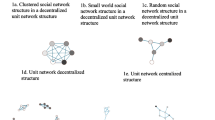Abstract
The increasing knowledge intensity of jobs, typical of a knowledge economy, highlights the role of firms as integrators of know-how and skills. As economic activity becomes mainly intellectual and requires the integration of specific and idiosyncratic skills, firms need to allocate skills to tasks and traditional hierarchical control results increasingly ineffective. In this work, we explore under what circumstances networks of agents, which bear specific skills, may self-organize in order to complete tasks. We use a computer simulation approach and investigate how local interaction of agents, endowed with skills and individual decision-making rules, may produce aggregate network structure able to perform tasks. To design algorithms that mimic individual decision-making, we borrow from computer science literature and, in particular, from studies addressing protocols that produce cooperation in Peer-to-Peer networks. We found that self-organization depends on the structural features of, formal or informal, organizational networks embedding both professionals, holding skills, and project managers, holding access to jobs.











Similar content being viewed by others
Notes
The software code can be obtained sending an e-mail to the second author of this paper.
A cut vertex is a vertex of a graph such that removal of the vertex causes an increase in the number of connected components.
References
Adler PS (2001) Market, hierarchy, and trust: the knowledge economy and the future of capitalism. Organ Sci 12(2):215–234
Brown JS, Duguid P (2001) Knowledge and organization: a social-practice perspective. Organ Sci 12(2):198–213
Brusoni S, Prencipe A, Pavit K (2001) Knowledge specialization, organizational coupling, and the boundaries of the firm: why do firms know more than they make? Adm Sci Q 46:597–621
Carley KM (1992) Organizational learning and personnel turnover. Organ Sci 3(1):20–46
Carley KM, Lin Z (1997) A theoretical study of organizational performance under information distortion. Manag Sci 43(7):976–997
Dickinson DL, Isaac RM (1998) Absolute and relative rewards for individuals in team production. Manag Decis Econ 19(4/5):299–310. Laboratory Methods in Economics
Dohm A, Shniper L (2007) Occupational employment projections to 2016. Mon Labor Rev 130(11):86–125
Faraj S, Sproull L (2000) Coordinating expertise in software developments teams. Manag Sci 46(12):1554–1568
Foss N (2005) Strategy, economic organization, and the knowledge economy. The coordination of firms and resources. Oxford University Press, Oxford
Gladstein Ancona D (1990) Outward bound: strategies for team survival in an organizations. Acad Manag J 33(2):334–365
Glance NS, Huberman BA (1994) Social dilemmas and fluid organizations. In: Carley KM, Prietula MJ (eds) Computational organizational theory. Lawrence Erlbaum Associates, Hillsdale
Hales D, Arteconi S (2006) SLACER: a self-organizing protocol for coordination in peer-to-peer networks. IEEE Intell Syst 21(2):29–35
Hart S, Kurz M (1983) Endogenous formation of coalitions. Econometrica 51(4):1047–1064
Haveman HA (1993) Organizational size and change: diversification in the savings and loan industry after deregulation. Adm Sci Q 38:20–50
Hayek FA (1945) The use of knowledge in society. Am Econ Rev 35(4):519–530
Hilton M (2008) Skills for work in the 21st century: What does the research tell us? Acad Manag Perspect 22(4):63–78
Hodgson GM (1999) Economics & Utopia. Routledge, London
Hoegl M, Gemuenden HG (2001) Teamwork quality and the success of innovative projects: a theoretical concept and empirical evidence. Organ Sci 12(4):435–449
Ibarra H (1992) Structural alignments, individual strategies, and managerial action: elements toward a network theory of getting things done. In: Nohria N, Eccles RG (eds) Network and organizations. Structures, form, and action. Harvard Business School Press, Boston
Jelasity M, van Steen M (2002) Large-scale Newscast computing on the Internet. Internal report IR-503, Vrije Universiteit Amsterdam
Kirkman BL, Rosen B (1999) Beyond self-management: antecedents and consequences of team empowerment. Acad Manag J 42(1):58–74
Lin Z, Carley KM (1997) Organizational response: the cost performance tradeoff. Manag Sci 43(2):217–234
Marcozzi A, Hales D, Jesi G, Arteconi S, Babaoglu O (2005) Tag-based cooperation in peer-to-peer networks with Newscast. In: Czap H, Unland R, Branki C, Tianfield H (eds) Self-organization and autonomic informatics (I), vol 135, Frontiers in Artificial Intelligence and Applications. IOS Press, The Netherlands
Marschak J, Radner R (1972) Economic theory of teams. Yale University Press, New Haven
Moch MK, Morse EV (1977) Size, centralization and organizational adoption of innovation. Am Sociol Rev 42:716–725
Mollona E, Marcozzi A (2009) FirmNet: the scope of the firm and the allocation of tasks in a knowledge-based economy. Comput Math Organ Theory 15(2):109–126
Natter M, Mild A, Feurstein M, Drffner G, Taudes A (2001) The effect of incentive schemes and organizational arrangements on the new product development process. Manag Sci 47(8):1029–1045
Ouchi WG (1979) A conceptual framework for the design of organizational control mechanisms. Manag Sci 7:833–848
Rapoport A, Kahan JP (1984) Coalition formation in a five-person market game. Manag Sci 30(3):326–343
Saxberg BO, Slocum JW (1968) The management of scientific manpower. Manag Sci 14(8):B473–B489
Seidmann DJ, Winter E (1998) A theory of gradual coalition formation. Rev Econ Stud 65(4):793–815
Wageman R (2001) How leaders foster self-managing team effectiveness: design choices versus hands-on coaching. Organ Sci 12(5):559–577
Wright PW, Snell SA (1998) Toward a unifying framework for exploring fit and flexibility in strategic human resource management. Acad Manag Rev 23(4):756–772. http://peersim.sourceforge.net
Author information
Authors and Affiliations
Corresponding author
Additional information
The author “Mollona” acknowledges financial support from the research project FIRB # RBNE05BFRK named ‘TOCAI.IT: Knowledge-oriented technologies for enterprise aggregation in Internet’.
Rights and permissions
About this article
Cite this article
Mollona, E., Marcozzi, A. Self-emerging coordination mechanisms for knowledge integration processes. Mind Soc 8, 223–241 (2009). https://doi.org/10.1007/s11299-009-0057-2
Received:
Accepted:
Published:
Issue Date:
DOI: https://doi.org/10.1007/s11299-009-0057-2




